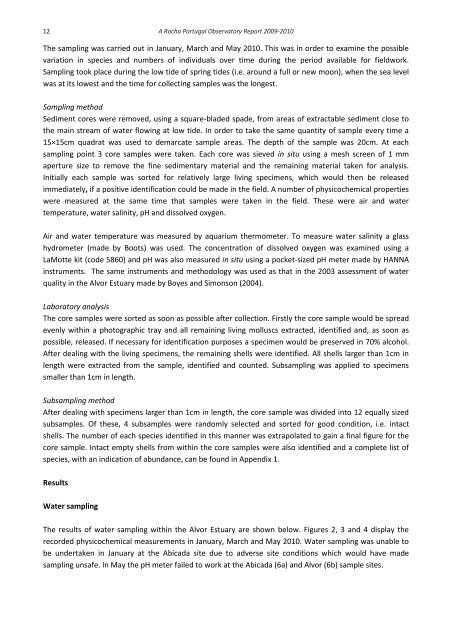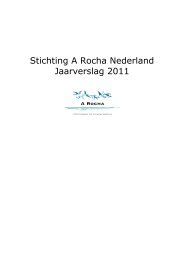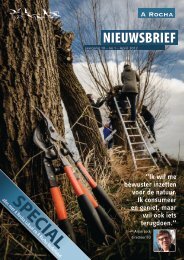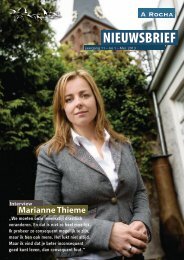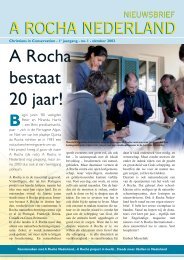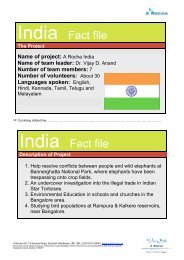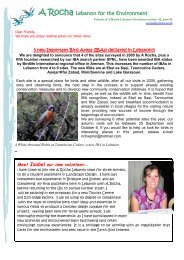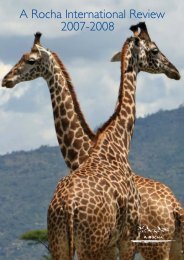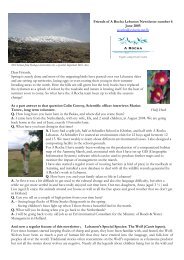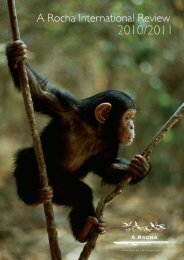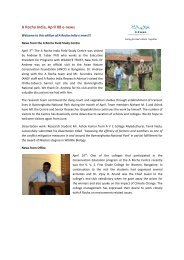A Rocha Portugal Observatory Report 2009-2010
A Rocha Portugal Observatory Report 2009-2010
A Rocha Portugal Observatory Report 2009-2010
You also want an ePaper? Increase the reach of your titles
YUMPU automatically turns print PDFs into web optimized ePapers that Google loves.
12 A <strong>Rocha</strong> <strong>Portugal</strong> <strong>Observatory</strong> <strong>Report</strong> <strong>2009</strong>-<strong>2010</strong><br />
The sampling was carried out in January, March and May <strong>2010</strong>. This was in order to examine the possible<br />
variation in species and numbers of individuals over time during the period available for fieldwork.<br />
Sampling took place during the low tide of spring tides (i.e. around a full or new moon), when the sea level<br />
was at its lowest and the time for collecting samples was the longest.<br />
Sampling method<br />
Sediment cores were removed, using a square-bladed spade, from areas of extractable sediment close to<br />
the main stream of water flowing at low tide. In order to take the same quantity of sample every time a<br />
15×15cm quadrat was used to demarcate sample areas. The depth of the sample was 20cm. At each<br />
sampling point 3 core samples were taken. Each core was sieved in situ using a mesh screen of 1 mm<br />
aperture size to remove the fine sedimentary material and the remaining material taken for analysis.<br />
Initially each sample was sorted for relatively large living specimens, which would then be released<br />
immediately, if a positive identification could be made in the field. A number of physicochemical properties<br />
were measured at the same time that samples were taken in the field. These were air and water<br />
temperature, water salinity, pH and dissolved oxygen.<br />
Air and water temperature was measured by aquarium thermometer. To measure water salinity a glass<br />
hydrometer (made by Boots) was used. The concentration of dissolved oxygen was examined using a<br />
LaMotte kit (code 5860) and pH was also measured in situ using a pocket-sized pH meter made by HANNA<br />
instruments. The same instruments and methodology was used as that in the 2003 assessment of water<br />
quality in the Alvor Estuary made by Boyes and Simonson (2004).<br />
Laboratory analysis<br />
The core samples were sorted as soon as possible after collection. Firstly the core sample would be spread<br />
evenly within a photographic tray and all remaining living molluscs extracted, identified and, as soon as<br />
possible, released. If necessary for identification purposes a specimen would be preserved in 70% alcohol.<br />
After dealing with the living specimens, the remaining shells were identified. All shells larger than 1cm in<br />
length were extracted from the sample, identified and counted. Subsampling was applied to specimens<br />
smaller than 1cm in length.<br />
Subsampling method<br />
After dealing with specimens larger than 1cm in length, the core sample was divided into 12 equally sized<br />
subsamples. Of these, 4 subsamples were randomly selected and sorted for good condition, i.e. intact<br />
shells. The number of each species identified in this manner was extrapolated to gain a final figure for the<br />
core sample. Intact empty shells from within the core samples were also identified and a complete list of<br />
species, with an indication of abundance, can be found in Appendix 1.<br />
Results<br />
Water sampling<br />
The results of water sampling within the Alvor Estuary are shown below. Figures 2, 3 and 4 display the<br />
recorded physicochemical measurements in January, March and May <strong>2010</strong>. Water sampling was unable to<br />
be undertaken in January at the Abicada site due to adverse site conditions which would have made<br />
sampling unsafe. In May the pH meter failed to work at the Abicada (6a) and Alvor (6b) sample sites.


